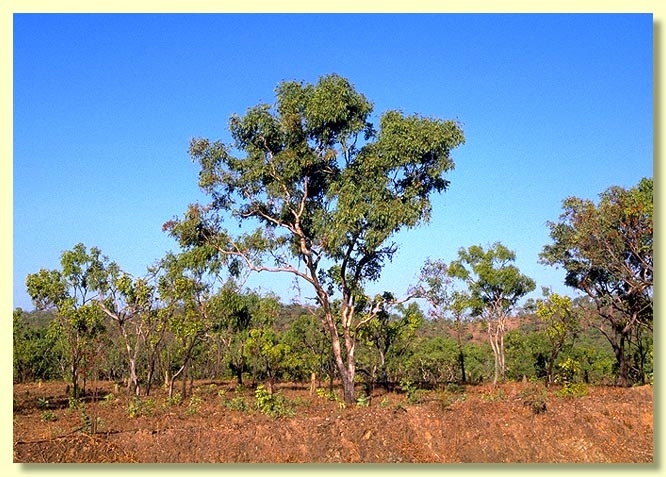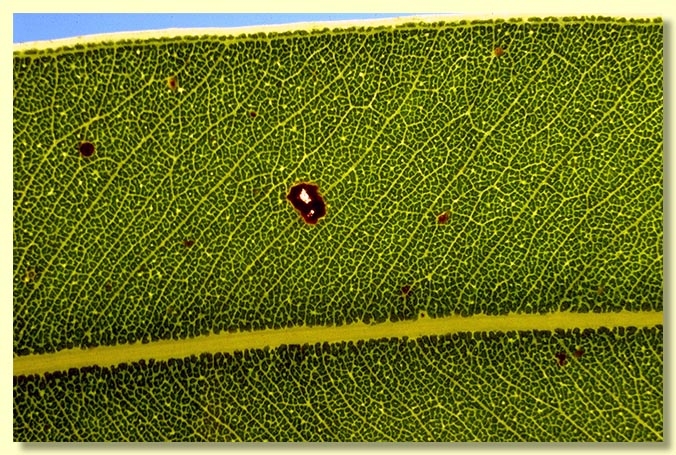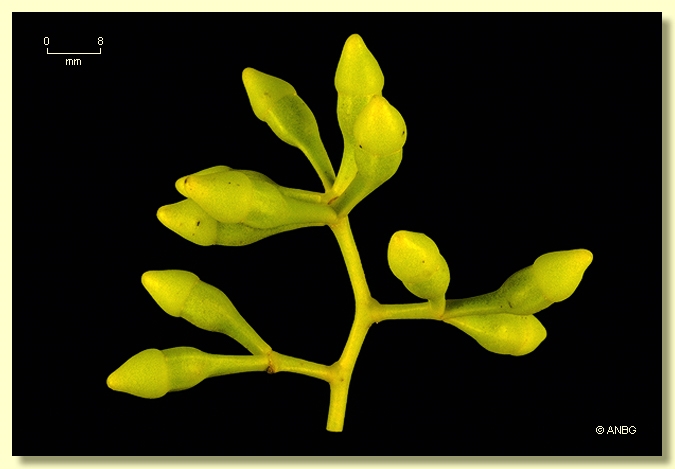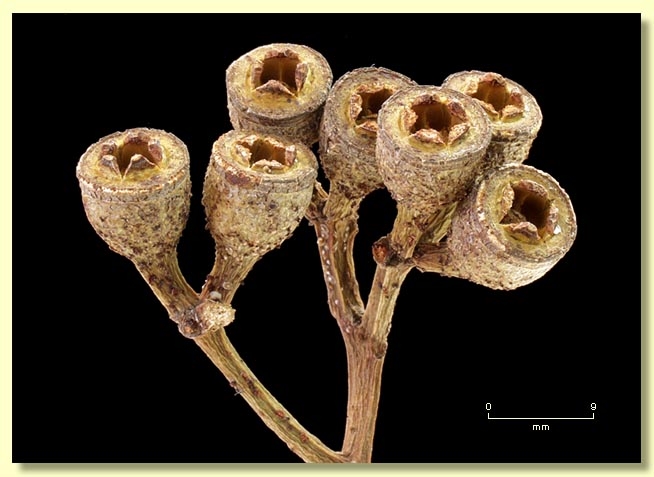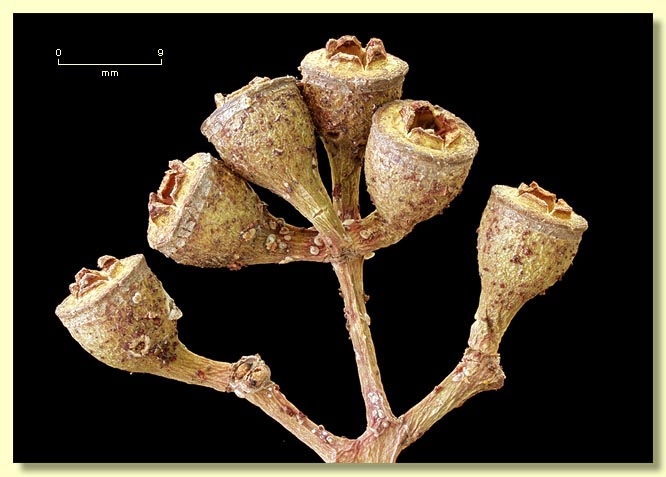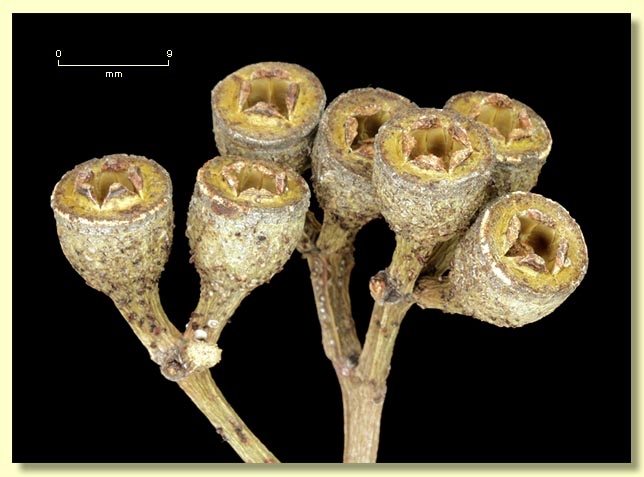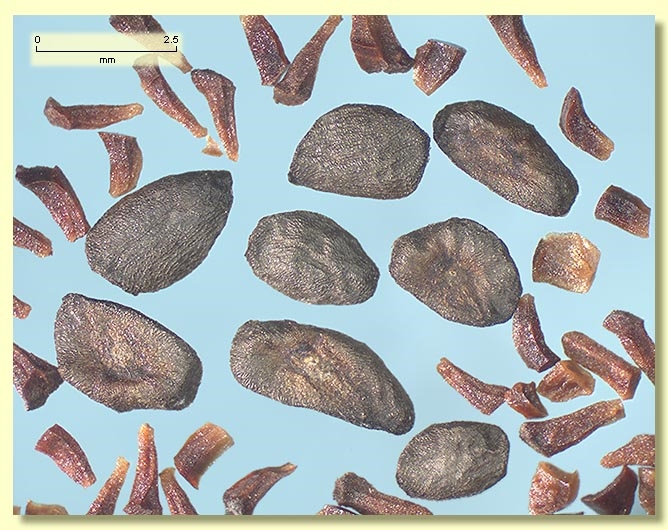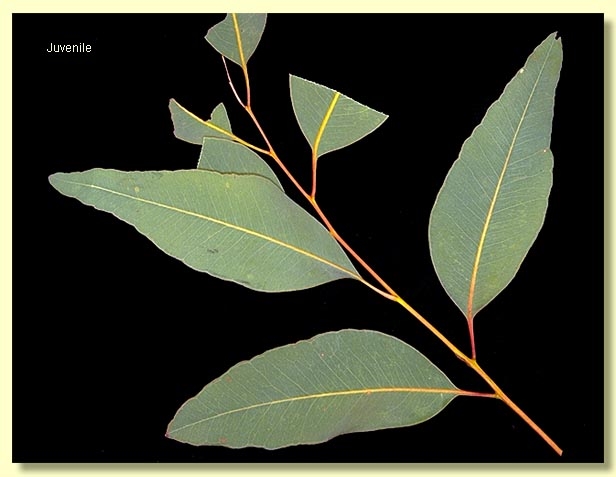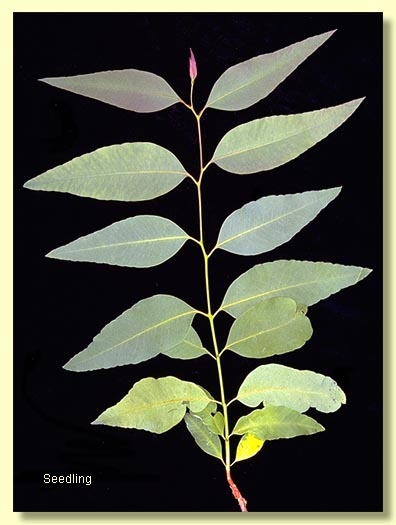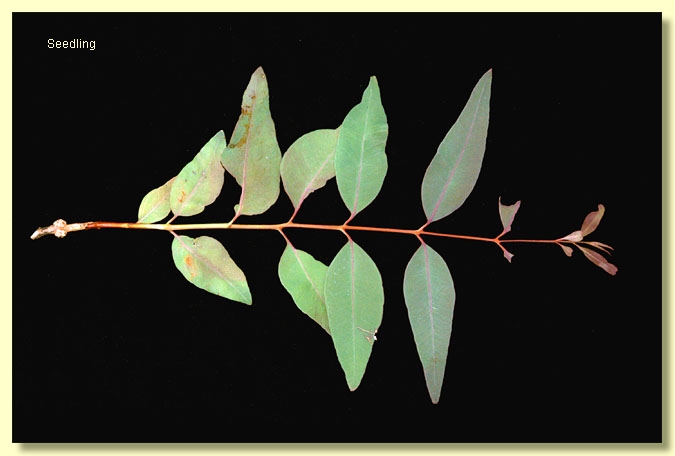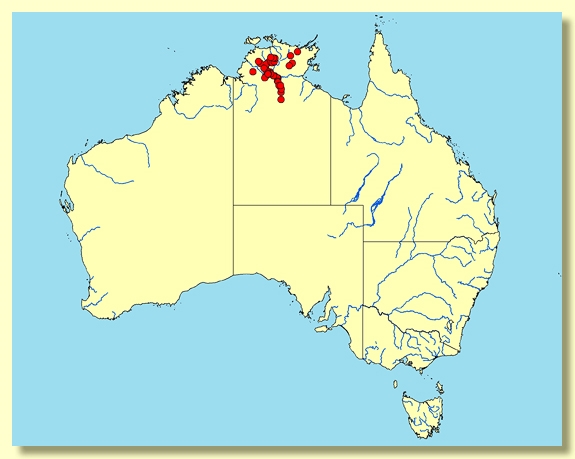Euclid - Online edition
Eucalyptus patellaris
Eucalyptus | Symphyomyrtus | Adnataria | Apicales | Aquilonares | Fortes
Eucalyptus patellaris F.Muell., J. Proc. Linn. Soc., Bot. 3: 84 (1859).
T: upper part of Roper River, Northern Territory, 3 July 1856, F.Mueller s.n.; holo: K.
Tree to 15 m tall. Forming a lignotuber.
Bark rough to small branches, finely fissured, box-type becoming tessellated on larger trunks, grey to grey-white.
Branchlets lack oil glands in the pith; not glaucous.
Juvenile growth (coppice or field seedlings to 50 cm): stems rounded in cross-section; juvenile leaves always petiolate, alternate, ovate, 9–13.5 cm long, 3.5–6 cm wide, base tapering to rounded, dull green.
Adult leaves alternate, petioles 0.8–2.6 cm long; blade lanceolate to narrowly so, or falcate, (8.2)9.5–27 cm long, 1.3–3.5(4.8) cm wide, base tapering to petiole, margin entire, apex pointed, concolorous, dull to glossy, green, side-veins acute or at more than 45° to midrib, reticulation dense to very dense, intramarginal vein close to margin, oil glands sparse, intersectional.
Inflorescence terminal compound, peduncles ± rounded, 0.5–2.5 cm long, buds 7 per umbel but occasionally irregular due to internode elongation within an umbel, pedicels 0.4–1.2 cm long. Mature buds pyriform to obovoid, widest at the join of operculum and hypanthium when bud is mature, 0.9–1.6 cm long, ca 0.6–0.9 cm wide, scar present (outer operculum shed early), operculum beaked to conical or turban-shaped, stamens usually irregularly flexed, all fertile, anthers adnate, basifixed, cuboid, dehiscing by lateral slits, style long and straight, stigma blunt, locules 4 or 5(6), the placentae each with 4 vertical ovule rows. Flowers white.
Fruit pedicels 0.2–1 cm long, usually campanulate or cupular or rarely almost cylindrical, 0.6–1.2 cm long, 0.6–1.3 cm wide, rim prominent sometimes flared, disc level to very slightly descending, valves 4 or 5(6), rim level or exserted.
Seeds dark brown, 1.5–4 mm long, flattened-ovoid, dorsal surface shallowly reticulate, hilum ventral.
Cultivated seedlings (measured at ca node 10): cotyledons large, reniform; stems rounded to square in cross-section; leaves always petiolate (petioles 0.4–1.2 cm), opposite for 6 to 9 nodes then becoming alternate, lanceolate to broadly so, 5–13.5 cm long, 1.5–3.8 cm long, base tapering, apex pointed, dull, green, ± concolorous.
Flowering has been recorded in January, February, November and December.
A tree endemic to the Top End of the Northern Territory, restricted in distribution to loamy and gravelly flats along streams or drainage lines in the area from south-west of Katherine to Daly Waters and north to Pine Creek and scattered elsewhere west, north-west and north-east of the Arnhem Land plateau, e.g. Goodparla, Jim Jim Creek, and north of Bulman, but absent from the elevated sandstone areas. A fully rough-barked box species, it is distinguished by the coarse campanulate fruits with exserted valves and green crown of pendulous long lanceolate leaves.
Eucalyptus patellaris is unlikely to be confused with any other species within its natural distribution. Earlier accounts of this species extended its range to the Pilbara region of Western Australia, but recent research has led to these plants being described as a new species, E. xerothermica.
In the classification of Brooker (2000) Eucalyptus patellaris belongs in Eucalyptus subgenus Symphyomyrtus section Adnataria (the boxes) because the buds have two opercula, ovules are in four rows, seeds are flattened-ovoid, cotyledons are reniform, and anthers are rigid on the staminal filaments. Within section Adnataria, E. patellaris belongs to a subgroup of box species with tropical distribution, series Aquilonares subseries Fortes, having inflorescences terminal on the branchlets, adult leaves very densely reticulate and fruit that are not fragile and have valves more or less at rim level when dehisced. The species making up subseries Fortes are E. leptophleba, E. leucophylla, E. koolpinensis, E. patellaris, E. oligantha and E. pruinosa. Three more tropical box species, E. limitaris, E. tephrodes and E. xerothermica, published since 2000 also belong in subseries Fortes
Eucalyptus patellaris: Latin patella, pan or knee-cap, erroneously referring to the shape of the operculum in the original description. The operculum is in fact conical to beaked.

